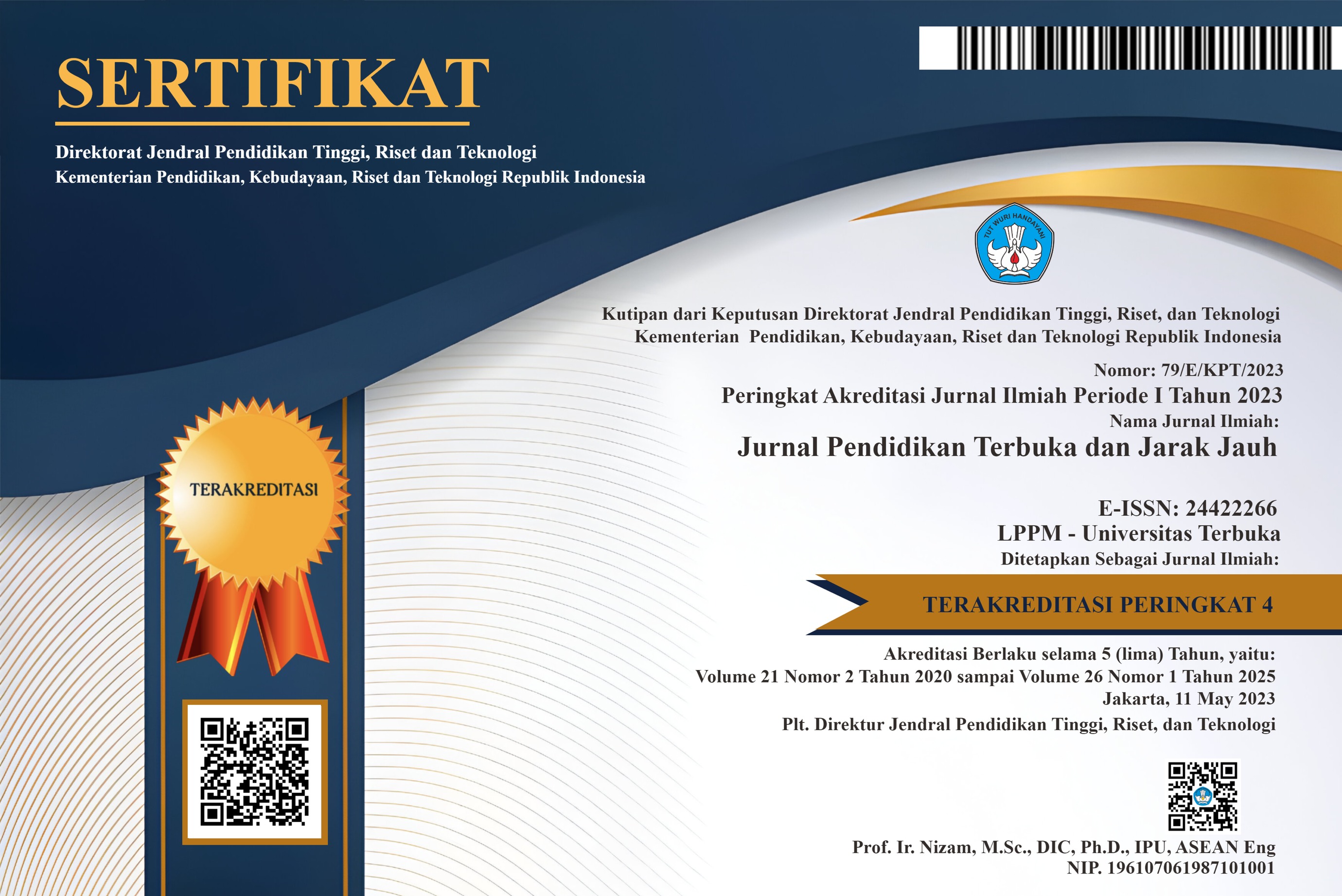SURVEI KESIAPAN DAN KEPUASAN MAHASISWA TERHADAP LAYANAN PROSES PEMBELAJARAN DALAM JARINGAN UNIVERSITAS TERBUKA SAAT PANDEMIC COVID 19
DOI:
https://doi.org/10.33830/ptjj.v20i2.839.2019Keywords:
online learning, online learning readiness, satisfaction, pandemic, COVID-19Abstract
During Covid-19 pandemic, online learning has been implemented as a strategic solution by many universities to prevent the spread of the Covid-19. This new teaching learning practice has encouraged researchers to conduct a survey of student readiness and satisfaction with the online learning services. This study aims to uncover two strategic issues including factors that influence student readiness and satisfaction and the level of student readiness and satisfaction dealing with online learning services. This research employs quantitative research methods using online surveys and involving all students who were actively registered in 2019 and 2020 both UT and non-UT students who participated in online learning services. Samples, however, were taken from all respondents covering western, central, and eastern Indonesia. It was discovered that structurally, supporting aspects contribute around 37%, prospect aspects 25%, benefit aspects 23%, and constraint aspects 11%, towards a dimension of the formation of participants' online learning perceptions. The findings show that participants have quite different views on supporting aspects, benefits, or prospects of online learning from the aspects of constraints. The relationship among the three distribution groups of variable categories shows three quite different positions in terms of participants' perceptions on online learning, namely accepting, moderate or opposing positions. Their opinion on online learning programs, during the Covid-19 outbreak, participants differed in their opposing positions on the one hand and moderate positions on the other, especially regarding costs, trends, and prices of devices/supporting equipment for online learning participants.
References
Al-alak, B. A., & Alnawas, I. A. (2011). Measuring the acceptance and adoption of e-learning by academic staff. Knowledge Management E-Learning International Journal, 3, 201–221.
Ali, G. E., & Magalhaes, R. (2008). Barriers to implementing e-learning: A Kuwaiti case study. International Journal of Training and Development, 12(1), 36–53. https://doi.org/10.1111/j.1468-2419.2007.00294.x
Baruah, T. D. (2018). E-Learning as a Medium for Facilitating Learners’ Support Services Under Open and Distance Learning: An Evaluative Study. Technology for Efficient Learner Support Services in Distance Education, 93–112. https://doi.org/10.1007/978-981-13-2300-3_5.
Butler, D. L., & Sellbom, M. (2002). Barriers to adopting technology for teaching and learning. Education Quarter, 2, 22–28.
Danesi, M. (2014). Encyclopedia of Media and Communication. Reference Reviews, 28(3), 20–21. https://doi.org/10.1108/rr-10-2013-0257
Griffin, E. A., Ledbetter, A., & Sparks, G. G. (2019). A first look at communication theory. /z-wcorg/.
Husson, F., Lê, S. & Pagès, J. (2017). Exploratory Multivariate Analysis by Example Using R. Boca Raton: CRC Press.
Husson, F., Josse, J., Lê, S., & Mazet, J. (2017). FactoMineR: Multivariate exploratory data analysis and data mining with R. R Package Version 1.35.
Katz, I., & Macklin-Smith, A. (2013). Information and Communication Technology (ICT) Literacy: Integration and Assessment in Higher Education.
Keegan, D. (2005). Theoretical Principles of Distance Education. https://doi.org/10.4324/ 9780203983065.
Kotler, P., & Kevin Lane Keller. (2015). Marketing Management: Analysis, Planning, and Control (15th ed.). Pearson. https://www.amazon.com/Marketing-Management-15th-Philip-Kotler/dp/0133856461/ref=tmm_hrd_swatch_0?_encoding=UTF8&qid=&sr=.
Lê, S., Josse, J., & Husson, F. (2008). FactoMineR: An R Package for multivariate analysis. Journal of Statistical Software, 25(1), 1–18. doi: 10.18637/jss.v025.i01.
Margaryan, A., Littlejohn, A., & Vojt, G. (2011). Are digital natives a myth or reality? University students’ use of digital technologies. Computers & Education, 56(2), 429–440. https://doi.org/10.1016/j.compedu.2010.09.004.
Marris, P., & Thornham, S. (2005). Media studies: A reader. Edinburgh University Press; /z-wcorg/.
Mohammadi, H. (2015). Investigating users’ perspectives on e-learning: An integration of TAM and IS success model. Computers in Human Behavior, 45, 359–374. https://doi.org/10.1016/j.chb.2014.07.044.
Parkes, M., Stein, S., & Reading, C. (2015). Student preparedness for university e-learning environments. The Internet and Higher Education, 25, 1–10. https://doi.org/10.1016/ j.iheduc.2014.10.002.
Prensky, M. (2001). Digital Natives, Digital Immigrants Part 1. On the Horizon, 9(5), 1–6. https://doi.org/10.1108/10748120110424816.
Wedemeyer, C. A. (1981). Learning at the back door. Reflections on non-traditional learning in the lifespan. Madison, WI: University of Wisconsin.





